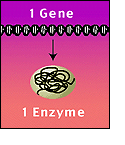Return to Online
Education Kit
|
 |
 |
 Previous Event | Next Event Previous Event | Next Event 
1941: One Gene, One Enzyme
 George Beadle and Edward Tatum, through experiments on the red bread mold Neurospora crassa, showed that genes act by regulating distinct chemical events – affirming the "one gene, one enzyme" hypothesis. George Beadle and Edward Tatum, through experiments on the red bread mold Neurospora crassa, showed that genes act by regulating distinct chemical events – affirming the "one gene, one enzyme" hypothesis.
George Beadle had spent two years in T. H. Morgan’s lab at Caltech, studying genetics using fruit flies as a model organism. In 1941, he and Edward Tatum turned to an even simpler model for studying genetics. In its normal, or "wild", state, the mold Neurospora crassa can grow on a medium containing just sugar, a small amount of biotin, and inorganic salts.
When the mold is exposed to X-ray radiation, mutations arise in occasional cells. Some of the mutations affect the mold’s ability to form organic compounds from simpler building blocks. For example, some lose the ability to assemble particular amino acids. To thrive, those strains need to have the particular amino acids supplied in their nutrient medium or, sometimes, they can make do with precursor compounds that the cells can convert into the required amino acids.
By supplying a variety of compounds in the nutrient medium and seeing which allow various mutant strains to grow and which don’t, Beadle and Tatum saw that they could deduce the sequence of biochemical reactions in cells that make necessary compounds like amino acids. The scientists concluded that the function of a gene is to direct the formation of a particular enzyme, which regulates a chemical event. A mutation can alter a gene so it no longer produces the normal enzyme, resulting in a physical symptom, like the need for nutritional supplements. Beadle and Tatum proposed that, in general, each gene directs the formation of one (and only one) enzyme.
For their work, Beadle and Tatum shared, with J. Lederberg, the 1958 Nobel Prize in Physiology or Medicine.
More Information
Reference:
Beadle, G.W., Tatum, E.L., Genetic control of biochemical reactions in Neurospora. Proc Natl Acad Sci, 27(11):499-506. 1941. [PubMed]
 Previous Event | Next Event Previous Event | Next Event 
Last Reviewed: April 14, 2008
|

